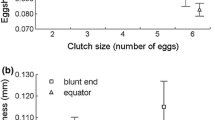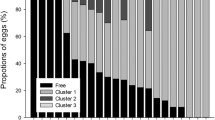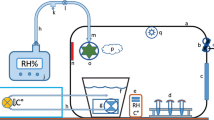Summary
This study determined how structural features of the eggshells of coots (Fulica americana) laid at 4150 m in the Peruvian Andes differed from those at sea level in Peru and California and how these features affected exchange of water vapor, O2, and CO2. While barometric pressure at 4150 m was reduced to 60% of that at sea level, the conductance to water vapor, corrected to 760 torr, of montane eggs was 107% of the corresponding lowland value. When the effect of low barometric pressure on the diffusion coefficient of gases was considered, the ‘effective’ conductance of the montane eggs at altitude was 177% of that at sea level. As a result, daily water loss from the montane eggs was substantially greater than that from lowland ones. The oxygen consumption of montane embryos was lower than that of lowland embryos of all sizes, particularly at larger embryonic masses. Just before pipping, the oxygen consumption of montane embryos was about 60% of the corresponding value for lowland individuals. Air cell oxygen tensions in montane eggs varied between about 65 and 38 torr; these values were about 60–70 torr below those in lowland eggs at equivalent embryonic masses. Just before pipping, the air cell CO2 tension of montane eggs was about 20 torr below levels in sea level eggs. The eggshell conductance to gases of montane eggs appears to have been selected to promote oxygen delivery at the cost of increased losses of water vapor and CO2.
Similar content being viewed by others
References
American Ornithologists' Union (1983) Check-list of North American birds, 6th edition. Washington DC
Ar A, Paganelli CV, Reeves RB Greene DG, Rahn H (1974) The avian egg: water vapor conductance, shell thickness and functional pore area. Condor 76:153–158
Ar A, Rahn H (1980) Water in the avian egg: overall budget of incubation. Am Zool 20:373–384
Ar A, Rahn H (1985) Pores in avian eggshells: gas conductance, gas exchange and embryonic growth rate. Respir Physiol 61:1–20
Ar A, Visschedijk AHJ, Rahn H, Piiper J (1980) Carbon dioxide in the chick embryo towards end of development: effects of He and SF in the breathing mixture. Respir Physiol 40:293–307
Blake ER (1977) Manual of neotropical birds, vol 1. University of Chicago Press, Chicago
Bucher TL, Barnhart MC (1984) Varied egg gas conductance, air cell gas tensions and development inAgapornis roseicollis. Respir Physiol 55:277–289
Carey C (1980) Adaptation of the avian egg to high altitude. Am Zool 20:449–459
Carey C (1983) Structure and function of avian eggs. In: Johnston RF (ed) Current ornithology, vol 1. Plenum Press, New York, pp 69–103
Carey C, Garber SD, Thompson EL, James FC (1983) Avian reproduction over an altitudinal gradient. II. Physical characteristics and water loss of eggs. Physiol Zool 56:340–352
Carey C, Leon-Velarde F, Castro G, Monge C (1987) Shell conductance, daily water loss, and water content of Andean gull and Puna ibis eggs. J Exp Zool [Suppl] 1:247–252
Carey C, Leon-Velarde F, Dunin-Borkowski O, Monge C (1989) Shell conductance, daily water loss, and water content of Puma teal eggs. Physiol Zool 62:83–95
Carey C, Thompson EL, Vleck CM, James FC (1982) Avian reproduction over an altitudinal gradient: incubation period, hatchling mass and embryonic oxygen consumption. Auk 99:710–718
Carmer SG, Swanson MR (1973) An evaluation of ten pairwise multiple comparison procedures by Monte Carlo methods. J Am Stat Assoc 68:66–74
Davis TA, Platter-Reiger MF, Ackerman RA (1984) Incubation water loss by pied-billed grebe eggs: adaptation to a hot wet nest. Physiol Zool 57:384–391
Drent RH (1970) Functional aspects of incubation in the herring gull. Behavior [Suppl] 17:1–132
Hoyt DF, Rahn H (1980) Respiration of avian embryos — a comparative analysis. Respir Physiol 39:255–264
Johnson AW (1965) The birds of Chile and adjacent regions of Argentina, Bolivia and Peru. Platt Establecimentos Graficos, SA. Buenos Aires, Argentina
Koepcke M (1964) The birds of the Department of Lima, Peru. Harrowood Books, New Square, Pennsylvannia
Leon-Velarde F, Whittembury J, Carey C, Monge C (1984) Permeability of eggshells of native chickens in the Peruvian Andes. In: Seymour RS (ed) Respiration and metabolism of embryonic vertebrates. Dr. W Junk, Dordrecht Boston London, pp 245–257
Monge C, Leon-Velarde F, Gomez de la Torre G (1988) Laying eggs at high altitude. NIPS 3:69–71
Packard GC, Sotherland PR, Packard MJ (1977) Adaptive permeability of avian eggshells to water vapour at high altitudes. Nature 266:255–256
Paganelli CV, Ackerman RA, Rahn H (1978) The avian egg: in vivo conductances to oxygen, carbon dioxide, and water vapor in late development. In: Piiper J (ed) Respiratory function in birds, adult and embryonic. Springer, Berlin Heidelberg New York, pp 212–218
Paganelli CV, Ar A, Rahn H, Wangensteen OD (1975) Diffusion in the gas phase: the effects of ambient pressure and gas composition. Respir Physiol 25:247–258
Paganelli CV, Rahn H (1984) Adult and embryonic metabolism in birds and the role of shell conductance. In: Seymour R (ed), Respiration and metabolism of embryonic vertebrates. Dr. W. Junk, Dordrecht Boston London, pp 193–204
Pettit TN, Whittow GC (1982) The initiation of pulmonary respiration in a bird embryo: blood and air cell gas tensions. Respir Physiol 48:199–208
Rahn H, Ar A (1974) The avian egg: incubation time and water loss. Condor 76:147–152
Rahn H, Carey C, Balmas K, Bhatia B, Paganelli CV (1977) Reduction of pore area of the avian eggshell as an adaptation to altitude. Proc Natl Acad Sci USA 74:3095–3098
Rahn H, Paganelli CV, Ar A (1974) The avian egg: air-cell gas tension, metabolism and incubation time. Respir Physiol 22:297–309
Romanoff AL (1967) Biochemistry of the Avian Embryo. Wiley, New York
Scholander PF (1947) Analyzer for accurate estimation of respiratory gases in one-half cubic centimeter samples. J Biol Chem 167:235–250
Sotherland PR, Ashen MD, Shuman RD, Tracy CR (1984) The water balance of bird eggs incubated in water. Physiol Zool 57:338–348
Sotherland PR, Packard GC, Taigen TL (1979) Permeability of magpie and blackbird eggshells to water vapor: variation among and within nests of a single population. Auk 96:192–195
Sotherland PR, Packard GC, Taigen TL, Boardman TJ (1980) An altitudinal cline in conductance of cliff swallow (Petrochelidon pyrrhonota) eggs to water vapor. Auk 97:177–185
Taigen TL, Packard GC, Sotherland PR, Boardman TJ, Packard MJ (1980) Water-vapor conductance of black-billed magpie (Pica pica) eggs collected along an altitudinal gradient. Physiol Zool 53:163–169
Visschedijk AHJ (1968) The air space and embryonic respiration. 3. The balance between oxygen and carbon dioxide in the air space of the incubating chicken egg and its role in stimulating pipping. Brit Poultr Sci 9:197–210
Visschedijk AHJ, Ar A, Rahn H, Piiper J (1980) The independent effects of atmospheric pressure and oxygen partial pressure on gas exchange of the chicken embryo. Respir Physiol 39:33–44
Vleck CEM, Hoyt DF, Vleck D (1979) Metabolism of avian embryos: patterns in altricial and precocial birds. Physiol Zool 52:363–377
Vleck CEM, Vleck D, Hoyt DF (1980) Patterns of metabolism and growth in avian embryos. Am Zool 20:405–416
Vleck D, Vleck CM, Hoyt D (1980) Metabolism of avian embryos: ontogeny of oxygen consumption in the rhea and emu. Physiol Zool 53:125–135
Walsberg G (1980) Microclimate of the avian nest. Am Zool 20:363–372
Wangensteen OD, Rahn H (1970/71) Respiratory gas exchange by the avian embryo. Respir Physiol 11:31–45
Wangensteen OD, Rahn H, Burton RR, Smith AH (1974) Respiratory gas exchange of high altitude adapted chick embryos. Respir Physiol 21:61–70
Wangensteen OD, Wilson D, Rahn H (1970/71) Diffusion of gases across the shell of the hen's egg. Respir Physiol 11:16–30
Author information
Authors and Affiliations
Rights and permissions
About this article
Cite this article
Carey, C., Leon-Velarde, F., Dunin-Borkowski, O. et al. Variation in eggshell characteristics and gas exchange of montane and lowland coot eggs. J Comp Physiol B 159, 389–400 (1989). https://doi.org/10.1007/BF00692411
Accepted:
Issue Date:
DOI: https://doi.org/10.1007/BF00692411




